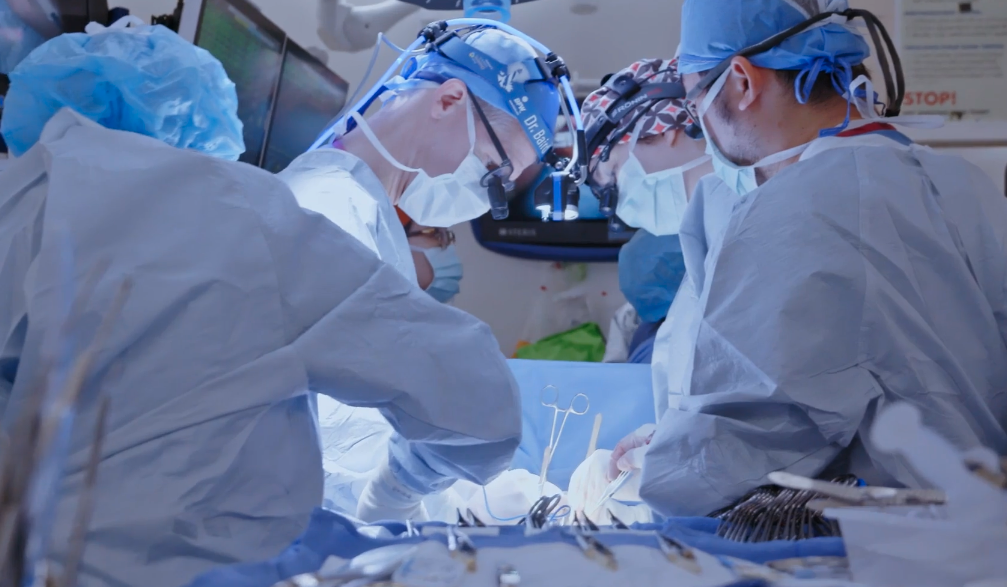Complex Biventricular Repair | Types of Biventricular Repairs
Double-switch operation for congenitally corrected transposition of the great arteries (cTGA)
A double-switch operation is used to correct congenitally corrected transposition of the great arteries, often referred to as L-TGA or CC-TGA. In this situation, both the ventricles and great arteries (aorta and pulmonary trunk) are transposed, meaning they are on the opposite side. Since this makes the right ventricle (instead of the left ventricle) the main pumping chamber, over time it can become strained and lead to heart failure. Some doctors will recommend leaving the right ventricle pumping blood to the body (conventional repair) because either no surgery is needed, or the surgery may be less complicated. Double-switch operations (anatomic repair) are designed to restore a normal anatomical arrangement where the right ventricle pumps deoxygenated blood to the lungs and the left ventricle pumps oxygenated blood to the body. The goal is to preserve ventricular function through anatomic repair, with the hope a near-normal functioning heart will improve a child’s quality of life.
Ventricular septation for double-inlet right or left ventricle
To treat double-inlet left ventricle or double-inlet right ventricle, we may perform a series of surgeries known as ventricular septation to create more efficient blood flow through a child’s heart. The first surgery begins to separate the ventricles, with the goal of streaming low-oxygen blood through one side of the heart to the lungs, and high-oxygen blood through the other side of the heart to the body. We typically perform ventricular septation in stages during early childhood. Sometimes ventricular septation involves maintaining a Glenn circulation of blood, which is similar to a one-and-a-half ventricle repair.
Staged ventricular recruitment for treatment of hypoplastic left heart syndrome (HLHS)
The goal of this series of procedures is to help “grow” a small, or borderline, left ventricle so that an infant’s heart strengthens enough to someday undergo a complete biventricular repair. The process consists of repairing the heart’s valves, closing a hole in the wall that separates the heart’s chambers (atrial septation), and enhancing blood flow to the lungs. Follow-up testing is typically performed some time in the next one to two years to see if the left ventricle has responded enough to undergo a biventricular repair.
Staged ventricular recruitment for unbalanced AV canal
This series of surgeries treats atrioventricular canal defect (AV canal). Typically in an unbalanced AV canal, blood flow is entering more into one ventricle than the other. The ventricle that is not receiving enough blood may become too small or underdeveloped to support a normal circulation. There can also be valve leakage that causes the ventricles to become overworked and fail.
The goal of staged recruitment for the unbalanced AV canal is to repair the AV valve in such a way that allows blood to be distributed proportionately between the two ventricles. This allows each ventricle to develop and grow properly. Sometimes, this can be completed in one surgery. For other cases, we prefer to stage the procedure to ensure each ventricle develops well after the initial valve surgery, and to make sure the valves are appropriately sized for biventricular circulation. Some children with unbalanced AV canal have biventricular repairs but eventually need more valve surgery or valve replacements. However, many of these patients need more valve surgery after the Fontan procedure anyway, because an AV canal defect can make the AV valve leak.
Biventricular repair for previously palliated single ventricle
We may recommend a change in strategy toward a biventricular repair for children who have already had a Norwood, Glenn, or Fontan procedure. The strategy aims to convert the ventricular arrangement into two pumping ventricles. A conversion to biventricular circulation from a Fontan is generally considered a big change in circulation, and may be more unpredictable than staged recruitment before the Fontan. If our team can choose the timing of biventricular repair, we typically recommend it after the Norwood or Glenn procedures but before the Fontan.
Complex baffle repairs for DORV and complex transposition
Many of the techniques mentioned above are used in the repair of double outlet right ventricle (DORV) and complex transposition of the great arteries (TGA). This anatomy often also requires a complex baffle repair to separate the right ventricle from the left ventricle, while also ensuring that blood has a clear pathway to exit each ventricle to its corresponding great artery outflow. We construct this pathway using a “ventricular baffle,” a patch that redirects bloodflow to its intended destination. Electrophsiology mapping is an important component in this procedure to ensure that the intricate placement of this baffle does not disrupt the heart’s conduction system.
One-and-a-half (1.5) ventricle repair for small right ventricle
When the right side of a child’s heart can’t handle the full volume of circulation, a one-and-a-half (1.5) ventricle repair, known as bidirectional Glenn, is a surgical option that reduces the heart’s workload by diverting some of the blood directly into the lungs.
'Reverse' double switch operation (rDSO) and reverse one-and-a-half (1.5) ventricle repair for small left ventricle
When the left side of a child’s heart is too small or can’t handle pumping blood to the while body, a “reverse” switch is a surgical option that reduces the heart’s left ventricle workload by allowing it to work under lower pressure by pumping blood only to the lungs. Meanwhile, the stronger right ventricle is left responsible for pumping blood to the body.
Complete biventricular repair
A single stage complete biventricular repair aims to fully reconstruct the underdeveloped pathways of complex congenital heart defects to give a child a normal, two-ventricle heart. It’s an innovative procedure that is performed in only one surgery.
Complex Biventricular Repair | Frequently Asked Questions
A complex biventricular repair can involve many surgeries and procedures (a process known as staged recruitment) over several months or years. Our team at the Complex Biventricular Repair Program performs the repair in several stages so we can carefully monitor your child’s heart and make sure it can tolerate each stage before we move forward with the next procedure.
The length of the repair process depends on your child’s specific heart condition, what types of surgeries they have already had, and their overall health.
Ideally, we prefer to begin the repair after a child has had a stage 1 procedure, around the time of their stage 2 bidirectional Glenn procedure, which usually occurs when they’re between 3 to 6 months old. We prefer to begin the repair before a child has had a Fontan procedure, but in some cases, we may consider a biventricular repair after the Fontan procedure.
Not all single ventricle patients are candidates for biventricular repair. If your child has one of the conditions we’ve mentioned, our team can review imaging of your child’s heart and offer an opinion. Submit a second opinion request.
The risks and complications of biventricular repair vary greatly and depend on the type of heart defect and your child’s overall health. Your cardiologist will discuss your child’s individual risks with you.
In some cases, a biventricular repair means more surgeries than the Fontan procedure. Sometimes additional surgeries may be required to repair or replace valves in the heart. There may be a risk of heart failure if the heart can’t tolerate the conversion to biventricular circulation. In some cases we perform the procedure in stages to minimize this risk, with an option to switch over to the Fontan procedure if biventricular staging doesn’t work as planned. Staging operations can allow us to make sure the heart can tolerate one procedure before we move onto the next step.
Children who have a biventricular repair will need to be followed and monitored throughout their lives by a cardiologist. We have treated many patients who had a complex biventricular repair because no other surgical options were available to them. We have also treated many patients who could have had a Fontan procedure, but instead had a biventricular repair. Many of these children are growing and thriving — and thanks to surgical innovations and more insight on how the heart develops, the long-term outlook for children who have these procedures only continues to improve.


